There’s something about a desert landscape — in all of its primitive, desolate beauty — that can both tug at the heartstrings and creep into the soul. Here, time seems to stand still: Resilient creatures move at a languid pace, icebergs gradually shift, and mirages ripple in the heat.
Though deserts have not inspired as many soliloquies and as much prose — or vacations — as Earth’s beaches, mountains and rainforests, they offer a uniquely rewarding type of travel experience. Following are five untamed deserts around the world that will quench your client’s sense of wanderlust.
Antarctica
Colossal glaciers drifting in frigid seawater and emperor penguins waddling adorably on ice — this likely isn’t the first image that comes to mind upon hearing the word “desert.” But Antarctica, indeed, is a desert: Precipitation is scarce, amassing an average of 2 inches each year in the continent’s inner regions. Winds can reach up to 200 miles per hour. And besides being the driest and coldest desert in the world, it’s also the largest, encompassing 5,400,000 square miles.
What’s more, Antarctica contains 90 percent of the Earth’s glacier ice. Two huge ice sheets (glacial land ice) cover nearly the entire continent, and their thickest point measures about 3 miles deep. Penguins greatly outnumber the human population of research station staff — 12 million to about 4,000 (in the summer) and 1,000 (during winter).
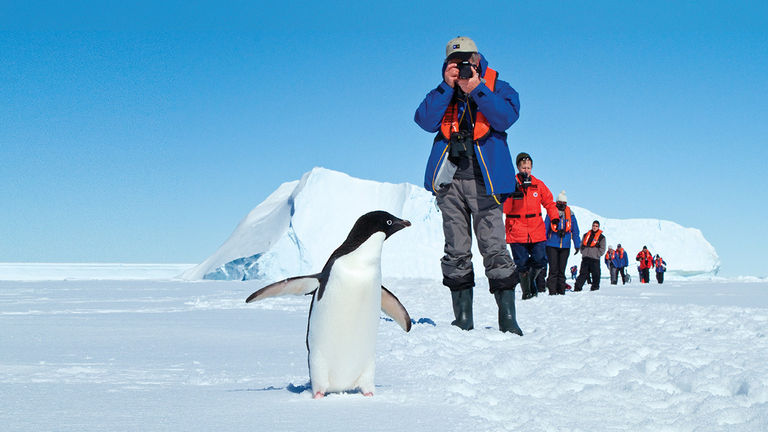 On Antarctica, there are 12 million resident penguins compared about 4,000 resident humans (in the summer) and 1,000 resident humans (during winter).
On Antarctica, there are 12 million resident penguins compared about 4,000 resident humans (in the summer) and 1,000 resident humans (during winter).
Credit: 2018 National Geographic ExpeditionSo, what does one do in a destination so still, so uninhabited and so remote — and with such stark beauty? Patrick Woodhead can tick off a few ideas. As co-founder and managing director of tour operator White Desert, which launched in 2005, he helps luxury travelers from all over (including Prince Harry in 2013) explore iridescent-blue ice tunnels, indulge in champagne-heavy picnics atop icebergs and take long walks overlooking massive coastal ice waves.
Clients arrive in style, too: A private jet whisks clients from South Africa’s Cape Town International Airport into the interior of Antarctica, landing at a private airstrip at the base of Ulvetanna Peak (known as “Wolf’s Fang”). At night, weary explorers rest their heads at Whichaway Camp: a cluster of six 20-foot-wide, heated, fiberglass pods that sleep up to two people each. They even contain a writing desk, in case inspiration strikes. For those flush with cash, but short on time, White Desert offers day trips as well.
If clients prefer to travel by ship, National Geographic-Lindblad makes the most of seven days off the Antarctic coast, allowing passengers to explore on foot, by kayak and by Zodiac. Sarah Erdman, senior editor for National Geographic Expeditions, urges passengers to muster up the courage for a true polar plunge — one that has folks wearing a bathing suit, not a wetsuit.
“You’ll be plucked out of the water by the team as fast as you jump in, but the exhilaration afterward lasts for hours,” she said.
Atacama Desert, Chile
On average, Northern Chile’s Atacama Desert sees less than 1 inch of annual rainfall, which has earned the roughly 41,000-square-mile plateau the designation of driest nonpolar desert on Earth. But its soil chemistry and extreme environment has been likened to that of another planet — Mars — so much so that in 2016, NASA began spending one month per year working in the heart of the Atacama, testing tools and techniques for future exploration on the Red Planet.
But the Atacama is more than just rusty-scarlet and rock-strewn topography. The active geysers, azure lagoons, crisp salt flats, sloping sand dunes and conical volcanoes that dot the landscape provide ample stimulus for adventure.
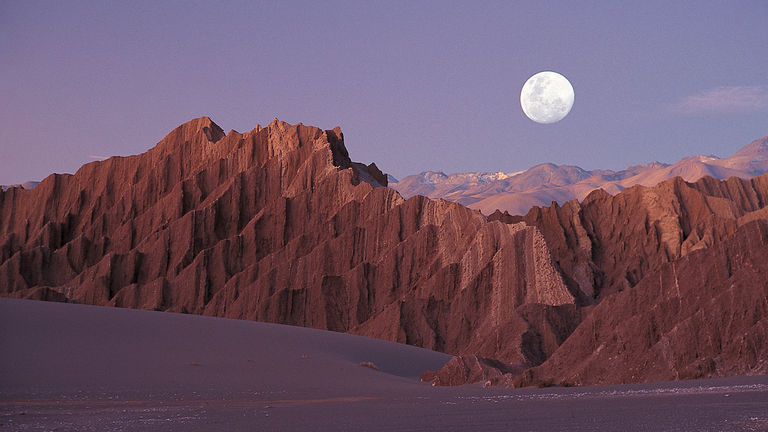 Chile's Atacama Desert features rocky mountains, conical volcanoes, sand dunes, sal flats, lagoons and more.
Chile's Atacama Desert features rocky mountains, conical volcanoes, sand dunes, sal flats, lagoons and more.
Credit: 2018 Exodus Travels
“You can go horseback riding or mountain biking with a local guide through surreal landscapes, or set out on a hike in the Valley of the Moon for a firsthand lesson about the wonders of geology,” said National Geographic Expeditions’ Erdman. “There are also perfect dunes that beckon to be climbed, and the more adventurous can ‘surf’ down via sandboarding.”
If clients can swing it (and if Lady Luck is on their side), try to time their trip to when the Atacama is expected to experience elusive rainfall, which occurs about every five to seven years.
“I was fortunate enough to be there on a rainy night, and the following day, all the surrounding mountains and volcanoes had snowy peaks, and the plains exploded into carpets of flowers,” said Malcolm Parkinson, product manager for South America at Exodus Travels. “They call it desierto florido, ‘the flowering desert.’”
Still, rain or shine, be sure to look up as soon as the sun goes down. With a high altitude, few clouds, a scant population and little light pollution, the Atacama features a star-studded, velvety night sky that has turned the desert into an astronomer’s paradise. Parkinson recommends booking passes to the renowned Atacama Large Millimeter Array (ALMA) Observatory well in advance; though admission is free, entry passes often sell out.
Gobi Desert, Mongolia
Stretching across 500,000 square miles in northern China and southern Mongolia, the Gobi Desert is a far cry from the romanticized sandy dunes often associated with desert terrain. The flaxen-gold sediment only covers about 3 percent of the vast territory, while barren expanses with lofty crags and dry ravines drag on endlessly.
The Gobi is arid due to its position in the Himalayas’ rain shadow, and some areas rise to 5,000 feet above sea level. Its climate is generally cold, but within 24 hours, temperatures can change drastically. In addition, high winds blow so fiercely that dust has carried as far as California’s Yosemite National Park, according to a 2017 scientific study by the University of California, Merced.
The Gobi Desert has a mythical character to it that inspires adventure and appeals to today’s travelers to push out more into the exotic.
Part of the Mongol Empire (gobi means “desert” in Mongolian), this desert once contained several cities along the ancient Silk Road. But long before camel-led caravans lugging Chinese wares trudged westward through the Gobi, prehistoric creatures — dinosaurs — ruled the land. Fossils of the first dinosaur eggs were found here in the 1920s by American paleontologist Roy Chapman Andrews, and from 1995 to 2008, more than 20,000 preserved dinosaur tracks were discovered in the vicinity.
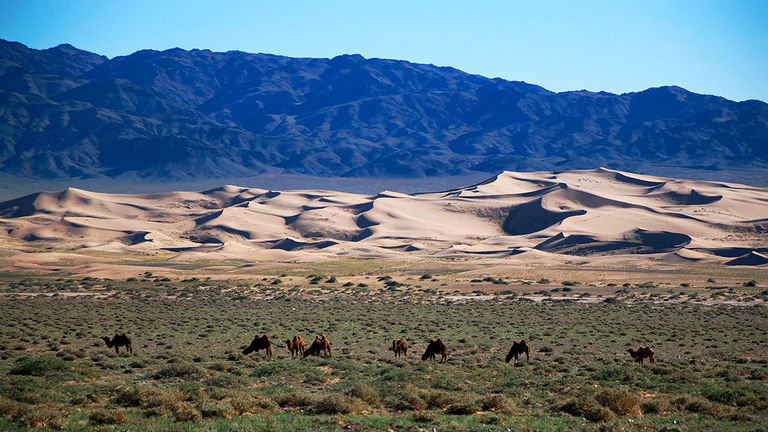 Nicknamed "the Singing Dunes," Khongoryn Els skirts the northern edge of the Gobi Desert.
Nicknamed "the Singing Dunes," Khongoryn Els skirts the northern edge of the Gobi Desert.
Credit: 2018 Creative Commons user misterpain
Barbara Banks, director of marketing and new trip development for Wilderness Travel, recommends paying a sunset visit to the Flaming Cliffs — the location of Andrews’ dinosaur egg unearthing — for an orangey-red spectacle. Another must-do, Banks says, is climbing Khongoryn Els (nicknamed the “Singing Dunes”) in Gobi Gurvansaikhan National Park, which skirts the desert’s northern edge.
“The grains of sand in these striking dunes are made of a certain type of silica that vibrates or hums as they cascade downward,” Banks said. “It’s a tough climb, but the view from the top of dunes, as far as you can see, is extraordinary. And then you get the fun of running down: the sand sliding underfoot and harmonizing into otherworldly sounds.”
Luxury operator Alexander + Roberts takes small groups on four-wheel drive vehicles from Ulaanbaatar, Mongolia’s urban capital city, into the desert. A naturalist guide tracks and points out native vegetation and wildlife, including black-tailed gazelles, Bactrian camels, snow leopards, ibex and argali sheep. Guests also meet local families in their yurts for a cup of suutei tsai (milky tea).
“The Gobi Desert has a mythical character to it that inspires adventure and appeals to today’s travelers to push out more into the exotic,” said Robert Drumm, Alexander + Roberts’ president. “The remoteness of the Gobi keeps all of our experiences authentic and untrammeled. We leave a light footprint.”
Namib Desert, Namibia
This desert’s official name, Namib Sand Sea, is quite literal — it’s a nod to the area’s naked vastness (namib means “open space”); burnt-orange sand; and proximity to the Atlantic Ocean. But most people know it simply as the Namib Desert, the oldest desert in the world: It dates back at least 55 million years.
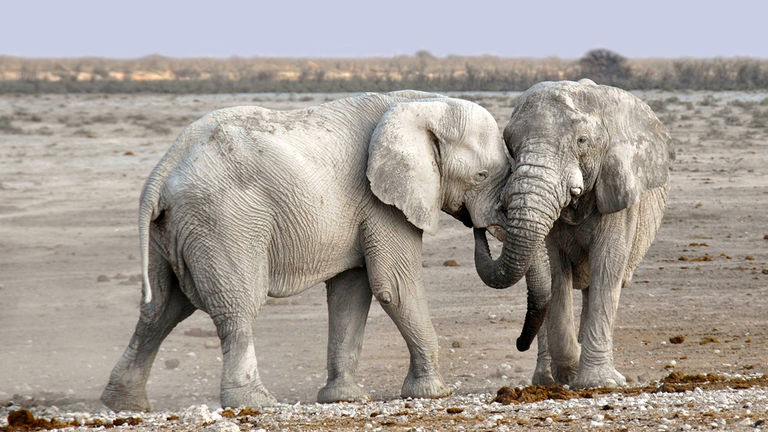 The Namib Desert in Namibia has desert-adapted elephants that go days without water.
The Namib Desert in Namibia has desert-adapted elephants that go days without water.
Credit: 2018 African Travel, Inc.In that time frame, native flora and fauna have evolved to survive in the brutal, parched environment. There’s an astounding amount of wildlife in the ancient desert, from critically endangered black rhinos and Peringuey’s adder (a venomous snake species) to desert-adapted elephants that can abstain from water for days. Rain, of course, is sparse; years can go by without any water falling from the sky. But the UNESCO-protected desert hugs Namibia’s coastline, and the sea provides a thick fog — and, as a result, moisture — for the local organisms.
A must-do is checking out the white claypan (an impermeable clay layer in soil) of Deadvlei, says Tom Harari, product manager for Africa at Exodus Travels. Camel-thorn trees that died some 600 years ago still stand amid the dunes, unable to decompose due to the tremendously dry air.
 Get a good (and beautiful) night's rest by sleeping on a rooftop "star bed" in the Namib.
Get a good (and beautiful) night's rest by sleeping on a rooftop "star bed" in the Namib.
Credit: 2018 African Travel, Inc.Close to Deadvlei is Sossusvlei. Perhaps the Namib’s most popular attraction, it is surrounded by monumental red-sand dunes that morph according to wind patterns. Climb and photograph the picturesque Dune 45, which is named for its distance — 45 kilometers — from the Sesriem gate (the entrance to Namib-Naukluft National Park, where Sossusvlei is located).
Sherwin Banda, president of African Travel, Inc., suggests sleeping under the moon on a rooftop “star bed” (a real bed located alfresco), and then taking in the panorama from a hot-air balloon, followed by a champagne breakfast.
“Sunrise and sunset are the best times to view the dunes,” he said. “They come alive in vibrant hues of orange, red and yellow in the changing light.”
Simpson Desert, Australia
The Simpson Desert has been called the “dead heart of Australia,” and for good reason: Its climate is exceedingly dry and hot, reaching as high as 122 degrees Fahrenheit in summer (though winters are considerably cooler). Extending to the corners of three states — Queensland, the Northern Territory and South Australia — it is the world’s largest parallel sand-dune desert, with more than 1,100 long, linear and red waves that ripple and swell from prevailing winds.
You’re truly in the middle of nowhere, so you feel very small in this huge desert. Once you’ve managed to drive up Big Red — a feat in itself — it’s peaceful.
Precipitation is rare; however, the Simpson does receive occasional flooding due to monsoonal rains that occur outside the region. Subsequently, rainwater flows through river conduits into the desert, transforming it into a blooming wonderland.
Clients should start their journey in Birdsville, a small town that sits on the edge of the Simpson. No lodging — beyond camping — is available within the desert; overnight accommodations are only available in Birdsville or at Mt Dare Hotel on the Simpson’s other side. To traverse the deep-vermillion land, travelers must use four-wheel drive vehicles.
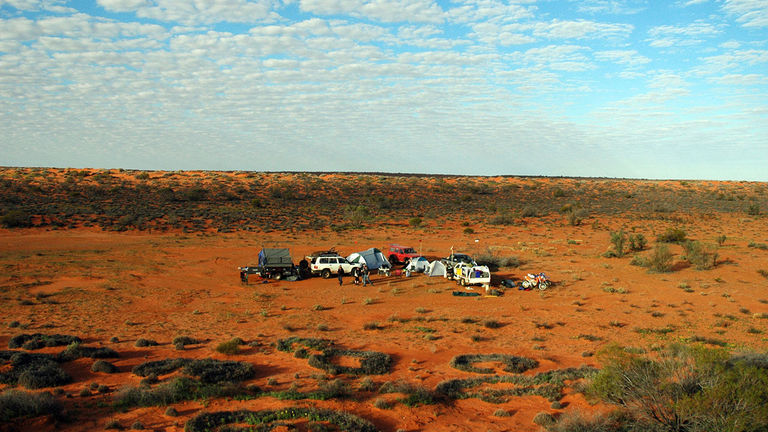 In Australia's Simpson Desert, only camping is available.
In Australia's Simpson Desert, only camping is available.
Credit: 2018 Creative Commons user jwbenwellMick Murdoch, manager of local operators SA Eco Tours and Australian Private Tours and Charters, stresses the importance of being prepared when crossing the desert.
“This area is the real outback and is not to be taken lightly,” he said. “You will need a well-equipped four-wheel drive vehicle with supplies and water to last for at least three days. A satellite phone is recommended, as there is no cellphone coverage once you leave the town of Coober Pedy in the north and mountain range Flinders Ranges in the south.”
Avoid visiting when it’s extremely hot, such as the months of December through February, advises Danielle Mobbs, director of local operator Sacred Earth Safaris. She adds that June and July are ideal — and the latter month is when Aussies and people from around the world turn out for the biggest, most remote music festival on the continent: Big Red Bash Music Festival, set at the base of the Simpson’s 131-foot-tall Big Red dune. Sacred Earth Safaris also visits Big Red (or Nappanerica) for a sunset experience on its 10-day Outback South Australia tours.
“You’re truly in the middle of nowhere, so you feel very small in this huge desert,” Mobbs said. “Once you’ve managed to drive up Big Red — a feat in itself — it’s peaceful.”